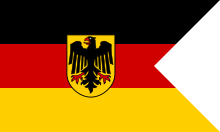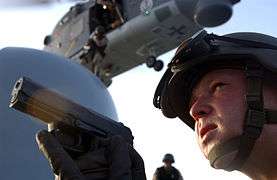German Navy
The German Navy (German: Deutsche Marine, officially German: Marine ![]()
| German Navy | |
|---|---|
| Deutsche Marine | |
 | |
| Founded | 2 January 1956 |
| Country | |
| Type | Navy |
| Size | 16,704 personnel (April 2020)[1] 65 ships 56 aircraft |
| Part of | Bundeswehr |
| Headquarters of the German Navy | Rostock (Navy Command) |
| Motto(s) | Wir. Dienen. Deutschland. (We. Serve. Germany.) |
| March | "Gruß an Kiel" |
| Anniversaries | 14 June |
| Engagements |
|
| Website | www |
| Commanders | |
| Inspector of the Navy | Vice Admiral Andreas Krause |
| Deputy Inspector of the Navy | Vice Admiral Rainer Brinkmann |
| Chief of Staff | Rear Admiral Thorsten Kähler |
| Notable commanders | |
| Insignia | |
| Naval ensign |  |
German Navy Deutsche Marine | |||||||||||||||||||||
|---|---|---|---|---|---|---|---|---|---|---|---|---|---|---|---|---|---|---|---|---|---|
| |||||||||||||||||||||
History
The German Navy traces its roots back to the Reichsflotte (Imperial Fleet) of the revolutionary era of 1848–52. The Reichsflotte was the first German navy to sail under the black-red-gold flag. Founded on 14 June 1848 by the orders of the democratically elected Frankfurt Parliament, the Reichsflotte's brief existence ended with the failure of the revolution and it was disbanded on 2 April 1852; thus, the modern day navy celebrates its birthday on 14 June.

Between May 1945 and 1956, the German Mine Sweeping Administration and its successor organizations, made up of former members of Nazi Germany's Kriegsmarine (War Navy), became something of a transition stage for the navy, allowing the future Marine to draw on recently experienced personnel upon its formation. Also, from 1949-52 the US Navy had maintained the Naval Historical Team in Bremerhaven. This group of former Kriegsmarine officers acting as historical and tactical consultants to the Americans, was significant in establishing a German element in the NATO senior naval staff. In 1956, with West Germany's accession to NATO, the Bundesmarine (Federal Navy), as the navy was known colloquially, was formally established. In the same year the East German Volkspolizei See (literally People's Police Sea) became the Volksmarine (People's Navy). During the Cold War all of the German Navy's combat vessels were assigned to NATO's Allied Forces Baltic Approaches's naval command NAVBALTAP.
With the accession of East Germany to the Federal Republic of Germany in 1990 the Volksmarine along with the whole National People's Army became part of the Bundeswehr. Since 1995 the name German Navy is used in international context, while the official name since 1956 remains Marine without any additions. As of April 2020, the strength of the navy is 16,704 men and women.[1]
A number of naval forces have operated in different periods. See
- Preußische Marine (Prussian Navy), 1701–1867
- Reichsflotte (Fleet of the Realm), 1848–52
- North German Federal Navy, 1867–71
- Imperial German Navy (Kaiserliche Marine), 1871–1919
- Reichsmarine, 1919–35
- Kriegsmarine, 1935–45
- German Mine Sweeping Administration, 1945–48
- Volksmarine, the navy of East Germany (GDR) 1956–90
- Marine, 1956–present (Bundesmarine, colloquially)
Current operations
German warships permanently participate in all four NATO Maritime Groups. The German Navy is also engaged in operations against international terrorism such as Operation Enduring Freedom and NATO Operation Active Endeavour.
Presently the largest operation the German Navy is participating in is UNIFIL off the coast of Lebanon. The German contribution to this operation is two frigates, four fast attack craft, and two auxiliary vessels. The naval component of UNIFIL has been under German command.[3]
The navy is operating a number of development and testing installations as part of an inter-service and international network. Among these is the Centre of Excellence for Operations in Confined and Shallow Waters (COE CSW), an affiliated centre of Allied Command Transformation. The COE CSW was established in April 2007 and officially accredited by NATO on 26 May 2009.[4] It is co-located with the staff of the German Flotilla 1 in Kiel whose Commander is double-hatted as Director, COE CSW.
Equipment
Ships and submarines
.jpg)
In total, there are about 65 commissioned ships in the German Navy, including; 10 frigates, 5 corvettes, 2 minesweepers, 10 minehunters, 6 submarines, 11 replenishment ships and 20 miscellaneous auxiliary vessels. The displacement of the navy is 220,000 tonnes.
Ships of the German Navy include:
- 4 Baden-Württemberg-class frigates F125 (2 commissioned, 2 planned commissioning during 2020–2021)
- 3 Sachsen-class frigates F124
- 4 Brandenburg-class frigates F123
- 1 Bremen-class frigate F122 (decommissioning planned for 2021)
- 5 K130 Braunschweig class corvettes (5 additional units in production, planned commissioning until 2025)
- 6 Type 212 submarine
In addition, the German Navy and the Royal Danish Navy are in cooperation in the "Ark Project". This agreement made the Ark Project responsible for the strategic sealift of German armed forces where the full-time charter of three roll-on-roll-off cargo and troop ships are ready for deployments. In addition, these ships are also kept available for the use of the other European NATO countries. The three vessels have a combined displacement of 60,000 tonnes.[5][6] Including these ships, the total ships' displacement available to the Deutsche Marine is 280,000 tonnes.
Procurement of Joint Support Ships (either two JSS800 for an amphibious group of 800 soldiers, or three smaller JSS400), was planned during the 1995–2010 period but the programme appears now to have been abandoned, not having been mentioned in two recent defence reviews. The larger ships would have been tasked for strategic troop transport and amphibious operations, and were to displace 27,000 to 30,000 tons for 800 soldiers.[7] The German Navy will use the Joint Support Ship HNLMS Karel Doorman (A833) of the Royal Netherlands Navy as part of the integration of the German Navy Marines (Seebatallion) in the Royal Netherlands Marine Corps as of 2016.
Aircraft
The naval air arm of the German Navy is called the Marinefliegerkommando. The Marinefliegerkommando operates 56 aircraft.
| Type | Origin | Class | Role | Introduced | In service | Total | Notes |
|---|---|---|---|---|---|---|---|
| Sea Falcon | Sweden | UAV | ISR | 2 systems on order as a testbed for future UAVs on the corvettes, 8 more planned | |||
| Puma AE II | United States | UAV | ISR | 2019 | 6 | 3 systems with 6 UAVs, dubbed "LARUS" in the German Navy[8] | |
| DJI Phantom 4 | China | Micro UAV | ISR | 2017 | 5 | [9] | |
| Dornier Do 228 | Germany | Propeller | Pollution control | 1996 | 2 | ||
| Lockheed P-3C Orion – CUP | United States | Propeller | MPA | 2006 | 8 | Former Royal Netherlands Navy | |
| NH90 Sea Lion | Germany | Rotorcraft | SAR/transport | 2018 | 4 | 14 more on order, replacing the Westland Sea King | |
| NH90 Sea Tiger | Germany | Rotorcraft | ASW | 2025 | 31 on order, replacing Westland Lynx[10] | ||
| Westland Lynx Mk.88 | UK | Rotorcraft | ASW | 1981 | 21 | Will be replaced by the NH90 Sea Tiger | |
| Westland Sea King Mk.41 | UK | Rotorcraft | SAR/transport | 1975 | 21 | Being replaced by the NH90 Sea Lion |
_of_the_German_Navy_at_RIAT_Fairford_17July2017_arp.jpg)

Structure
The German Navy is commanded by the Inspector of the Navy (Inspekteur der Marine) supported by the Navy Command (Marinekommando) in Rostock.
Formations
- HQ German Navy (Marinekommando), Rostock
- Einsatzflottille 1 (HQ Kiel)
- 1st Corvette Squadron (1. Korvettengeschwader), Warnemünde
- 1st Submarine Squadron (1. Ubootgeschwader), Eckernförde
- Submarine Training Centre (Ausbildungszentrum Unterseeboote), Eckernförde
- 3rd Minesweeping Squadron (3. Minensuchgeschwader), Kiel
- 5th Minesweeping Squadron (5. Minensuchgeschwader), Kiel
- 7th Fast Patrol Boat Squadron (7. Schnellbootgeschwader), Warnemünde
- Naval Force Protection Battalion, (Seebataillon), Eckernförde
- Naval Special Forces Command, (Kommando Spezialkräfte Marine), Eckernförde
- Naval Base Command Kiel (Marinestützpunktkommando Kiel)
- Naval Base Command Eckernförde
- Naval Base Command Warnemünde
- HQ 2nd Flotilla
- 2nd Frigate Squadron (2. Fregattengeschwader), Wilhelmshaven
- 4th Frigate Squadron (4. Fregattengeschwader), Wilhelmshaven
- Auxiliary Squadron (Trossgeschwader), Wilhelmshaven
- Naval Base Command Wilhelmshaven
- Naval Aviation Command (Marinefliegerkommando), Nordholz
- Naval Air Wing 3 (Marinefliegergeschwader 3), Nordholz
- Naval Air Wing 5 (Marinefliegergeschwader 5), Nordholz
- Naval Support Command (Marineunterstützungskommando — MUKdo)
- Naval Medical Institute (Schiffahrtsmedizinisches Institut), Kiel
- Naval Academy (Marineschule Mürwik), Flensburg
- Petty Officer School (Marineunteroffiziersschule), Plön
- Engineering School (Marinetechnikschule), Parow, near Stralsund
- Naval Operations School (Marineoperationsschule), Bremerhaven
- Naval Damage Control Training Centre (Ausbildungszentrum für Schiffssicherung), Neustadt in Holstein
Ranks
Officers
| NATO code | OF-10 | OF-9 | OF-8 | OF-7 | OF-6 | OF-5 | OF-4 | OF-3 | OF-2 | OF-1 | OF(D) | Student officer | ||||||||||||||||||||||||
|---|---|---|---|---|---|---|---|---|---|---|---|---|---|---|---|---|---|---|---|---|---|---|---|---|---|---|---|---|---|---|---|---|---|---|---|---|
(Edit) |
No equivalent |  |
 |
 |
 |
 |
 |
 |
 |
 |
 |
 |
 |
 |
 |
Enlisted rank plus a star indicating cadet's career | ||||||||||||||||||||
| Admiral | Vizeadmiral | Konteradmiral | Flottillen- admiral |
Kapitän zur See | Fregatten- kapitän |
Korvetten- kapitän |
Stabskapitän- leutnant |
Kapitän- leutnant |
Oberleutnant zur See |
Leutnant zur See |
Oberfähnrich zur See |
Fähnrich zur See |
Seekadett | |||||||||||||||||||||||
Petty officers and enlisted seamen
| NATO Code | OR-9 | OR-8 | OR-7 | OR-6 | OR-5 | OR-4 | OR-3 | OR-2 | OR-1 | |||||||||||||||||||||||||||
|---|---|---|---|---|---|---|---|---|---|---|---|---|---|---|---|---|---|---|---|---|---|---|---|---|---|---|---|---|---|---|---|---|---|---|---|---|
(Edit) |
 |
 |
 |
 |
 |
 |
 |
 |
 |
 |
 |
 |
 | |||||||||||||||||||||||
| Oberstabsbootsmann | Stabsbootsmann | Hauptbootsmann | Oberbootsmann | Bootsmann | Obermaat | Maat | Oberstabsgefreiter | Stabsgefreiter | Hauptgefreiter | Obergefreiter | Gefreiter | Matrose | ||||||||||||||||||||||||
(Officer designate) (Edit) |
No equivalent |
 |
 |
 |
No equivalent | |||||||||||||||||||||||||||||||
| Oberfähnrich zur See | Fähnrich zur See | Seekadett | ||||||||||||||||||||||||||||||||||
Radio and communication stations
- DH038
- DHJ58
- DHJ59
Future developments
- The German government has announced the selection in January 2020 and contracting in June 2020 of Damen Group as the main contractor, together with partners Blohm+Voss and Thales, for supplying four Multi-Purpose Combat Ship MKS 180 frigates ('Mehrzweckkampfschiff 180' ) to the German Navy with an option for 2 additional ships. The ships will be built at Blohm + Voss shipyard in Hamburg and at other shipyard locations of the North German Lürssen Group.[11]
- Two further-developed Type 212submarines with significant advancements (Common Design) will be designed & procured with Norway in the next decade.[12]
- Five additional Braunschweig class corvettes are ordered and will be delivered 2020–2023.[13]
- NH90 NFH 'Sea Tiger' Helicopters ordered to replace Lynx in ASW/AsuW role, originally ordered by the German Army as NH90 TTH variant with deliveries planned from 2025 onwards. Up to 31 could be ordered.
- 18 NH90 MRH 'Sealion' Helicopters are unarmed and will replace the current 21 Sea King helicopters of Naval Air Wing 5 in SAR and ship-based Transport Role (VertRep) with deliveries planned from 2019 onwards.
- The Saab Skeldar has been ordered as a testbed for a future maritime UAV for the Braunschweig class corvette.[14]
- Integration of the German Navy Marines (Seebatallion) in the Netherlands Marine Corps and use of the Amphibious ships of the Royal Netherlands Navy such as the Joint Support Ship HNLMS Karel Doorman (A833) as of 2016.
- In June 2020 it was announced that German Navy and Royal Netherland Navy will cooperate and plan the future replacement of both the Sachsen-class frigate and De Zeven Provinciën-class frigate from 2030 onwards.
- 2 Combat Support Ships (Type 707) planned to replace Rhön-Class ships (Type 704), introduction into service planned for 2025.
See also
- List of ship classes of the Bundesmarine and Deutsche Marine
- List of ships of the German navies
- List of admirals of the German Navy
- German commando frogmen
- Marineamt
- Marine-Regatta-Verein
- U-boat
- Volksmarine
Further reading (COE CSW)
- Jan Wiedemann: COE CSW celebrates fifth anniversary; in: NAVAL FORCES III/2014 p. 90 f.
- Hans-Joachim Stricker: Centre of Excellence for Operations in Confined and Shallow Waters COE CSW – Das COE als Ausdruck unserer besonderen nationalen Fähigkeiten im Bündnis; in: Marineforum 6-2007 p. 3 f.
- Fritz-Rudolf Weber: Centre of Excellence for Operations in Confined and Shallow Waters – Think Tank für die NATO; in: Marineforum 1/2-2010 p. 11 ff.
- Hans Georg Buss, Stefan Riewesell: Maritime C-IED and Harbour Protection: A Joint Effort; in: The Transformer Fall 2013 Vol 9 Issue 2 p. 18
- Rahn, Werner. "German Navies from 1848 to 2016: Their Development and Courses from Confrontation to Cooperation." Naval War College Review 70.4 (2017). online
References
- "Aktuelle Personalzahlen der Bundeswehr [Current personnel numbers of the Federal Defence]". Retrieved 28 May 2020.
- "Archived copy". Archived from the original on 31 March 2017. Retrieved 30 March 2017.CS1 maint: archived copy as title (link)
- "Bilanz und Ausblick". Archived from the original on 1 January 2009. Retrieved 18 December 2009.
- Deutsche Marine – press release: Neues Nato-Expertenzentrum an der Kieler Förde nimmt Fahrt auf; Faermann, 2009
- "The ships chartered for the ARK Project". Archived from the original on 8 June 2011. Retrieved 27 October 2010.
- "The ARK project". Archived from the original on 28 November 2010. Retrieved 27 October 2010.
- "Inspekteur der Marine : Zielvorstellung Marine 2025+" (PDF). Geopowers.com. Archived (PDF) from the original on 1 June 2010. Retrieved 14 March 2016.
- https://www.flugrevue.de/militaer/unbemanntes-fluggeraet-von-aerovironment-puma-ae-fuer-die-marine/
- http://dipbt.bundestag.de/doc/btd/19/010/1901082.pdf
- Thomas Wiegold (31 July 2019). "Marine soll NH90-Hubschrauber als Ersatz für SeaLynx bekommen (m. Nachtrag)". Augen geradeaus!. Retrieved 7 August 2019.
- damen.com - DAMEN AND BLOHM + VOSS SELECTED FOR CONSTRUCTION GERMAN MKS180 FRIGATES (14 January 2020).
- Nachrichtenfernsehen, n-tv. "Marine stellt U36 in Dienst: Bundeswehr bekommt neue U-Boote". n-tv.de. Archived from the original on 13 October 2016. Retrieved 8 November 2016.
- "Koalition will Boote kaufen: Bundeswehr soll fünf neue Korvetten bekommen". Frankfurter Allgemeine Zeitung. 14 October 2016. ISSN 0174-4909. Archived from the original on 15 October 2016. Retrieved 8 November 2016.
- "Archived copy". Archived from the original on 30 September 2018. Retrieved 30 September 2018.CS1 maint: archived copy as title (link)
External links
| Wikimedia Commons has media related to Navy of Germany. |
